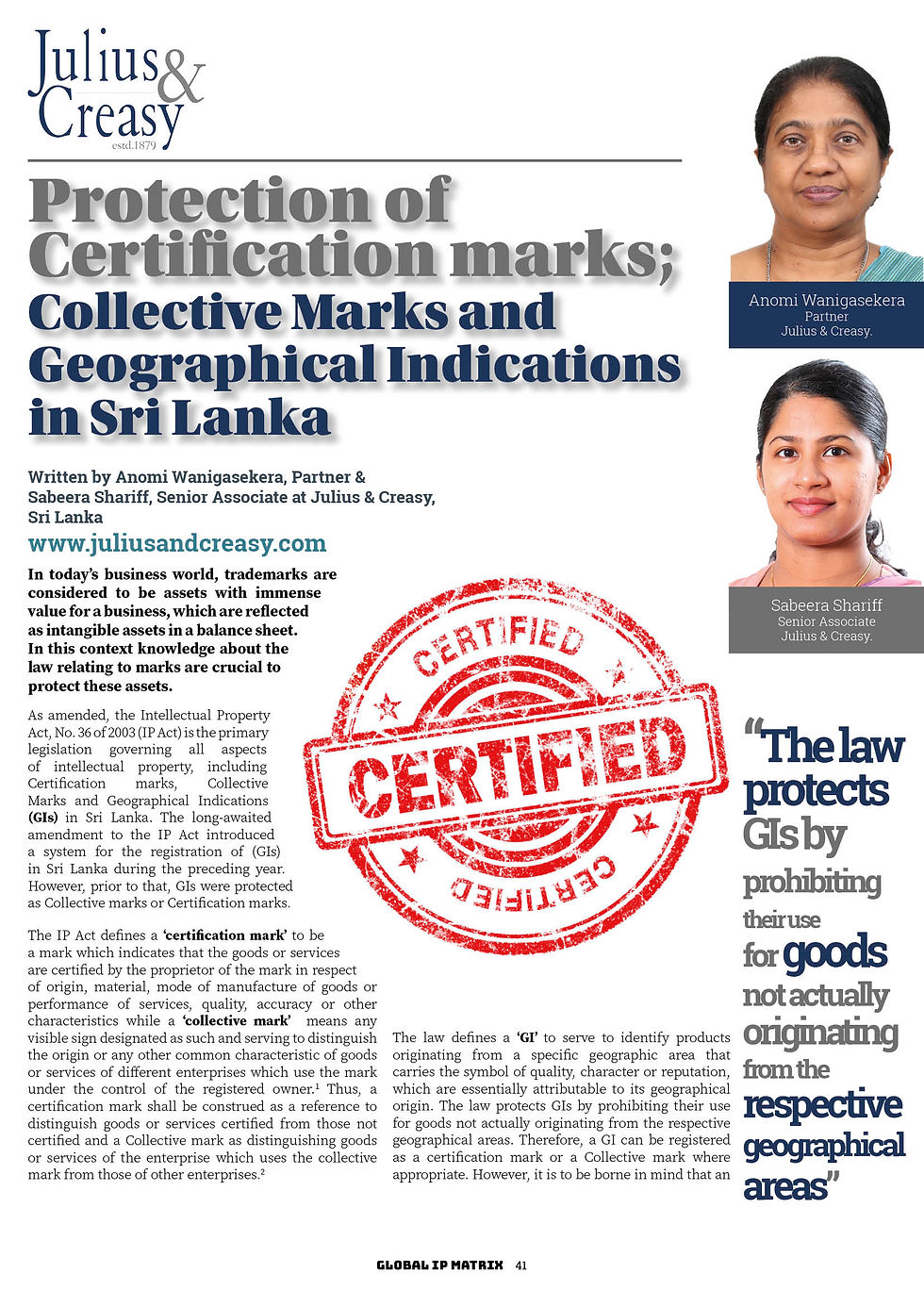Protection of Certification marks; Collective Marks and Geographical Indications in Sri Lanka By Anomi Wanigasekera, Partner & Sabeera Shariff
- Dakhani Dhruva

- Feb 15, 2024
- 2 min read
Updated: Apr 3, 2024
Protection of Certification marks; Collective Marks and Geographical Indications in Sri Lanka By Anomi Wanigasekera, Partner & Sabeera Shariff: In the bustling landscape of today's business world, trademarks stand as valuable assets, reflecting a company's identity and reputation. But how does Sri Lanka safeguard its distinctive products in the global market? Anomi Wanigasekera and Sabeera Shariff, legal experts from Julius & Creasy, Sri Lanka, shed light on the protection of Certification marks, Collective marks, and Geographical Indications (GIs) under the Intellectual Property Act, No. 36 of 2003.
Certification marks certify the origin, material, quality, or other characteristics of goods or services, ensuring consumers of their authenticity. On the other hand, collective marks distinguish goods or services of different enterprises sharing common characteristics under the control of a registered owner. These marks play a crucial role in preserving the integrity and reputation of Sri Lankan products in the marketplace.
Geographical Indications (GIs) identify products originating from specific geographic areas known for their quality, reputation, or characteristics attributable to their origin. Sri Lanka recently introduced a registration process for GIs, allowing associations or organizations representing producers to apply for GI protection. This initiative aims to safeguard iconic Sri Lankan products, such as Ceylon Tea and Ceylon Cinnamon, from unauthorized use and misrepresentation. Navigating the Registration Process To register Certification marks, Collective marks, or GIs, applicants must adhere to specific requirements outlined in the Intellectual Property Act. Detailed regulations governing the use of the mark, quality standards, and control mechanisms are essential for successful registration. Additionally, foreign GIs can also seek protection in Sri Lanka, provided they meet certain criteria.
Registered owners of Certification marks, Collective marks, and GIs enjoy legal protection against unauthorized use through civil and criminal litigation. Sri Lanka Customs plays a vital role in preventing the importation and exportation of goods infringing on trademark and GI rights. Therefore, proactive registration of marks with customs authorities is crucial for effective enforcement. Looking Ahead: Opportunities and Challenges
As Sri Lanka continues to expand its global footprint, the protection of Certification marks, Collective marks, and GIs presents both opportunities and challenges. Strengthening enforcement mechanisms, enhancing public awareness, and fostering collaboration between stakeholders are essential for maximizing the potential of Sri Lanka's unique products in the international market. Anomi Wanigasekera and Sabeera Shariff
Conclusion
In conclusion, the protection of Certification marks, Collective marks, and Geographical Indications is instrumental in safeguarding Sri Lanka's legacy and promoting economic prosperity. By adhering to robust intellectual property laws and fostering collaboration among stakeholders, Sri Lanka can continue to showcase its unique products on the global stage, ensuring their authenticity and preserving their cultural significance for generations to come. Read The Full Article By Anomi Wanigasekera, Partner & Sabeera Shariff Our Latest Edition on The Global IP Matrix.







Comments